5 Greek Islands that Shine in September
Discover Greece’s islands in September with...

Spring arrived in Afionas, the village of northern Corfu, where the path to Porto Timoni begins.
© Nicholas Mastoras
Spring is almost here but not quite yet; dry branches are entangled with greenery and flowers. And we, together with a group from the Corfu Hiking Association, are crossing the middle part of Corfu heading towards the south.
Starting from Benitses, we are passing through a landscape full of olives, cypresses and strawberry trees, we are reaching the springs of the old English aqueduct, a remnant of the British occupation, we are advancing towards Makrata, Dafnata and Komianata (areas where the last names Makris, Dafnis and Komianos are common), we are gazing like true watchmen at the view to mainland Greece and Albania, which are located right across from here and we are going up to the church of Pantokratoras, Pantokratoreli as the locals call it, for a family photo ̶ not digital but analog, using a new generation Polaroid, to have the impression of the trip in our hands. We return back to Dafnata (9km/3½hours/altitude difference of 450m), but we could have continued by taking an alternative path that leads back to Benitses.
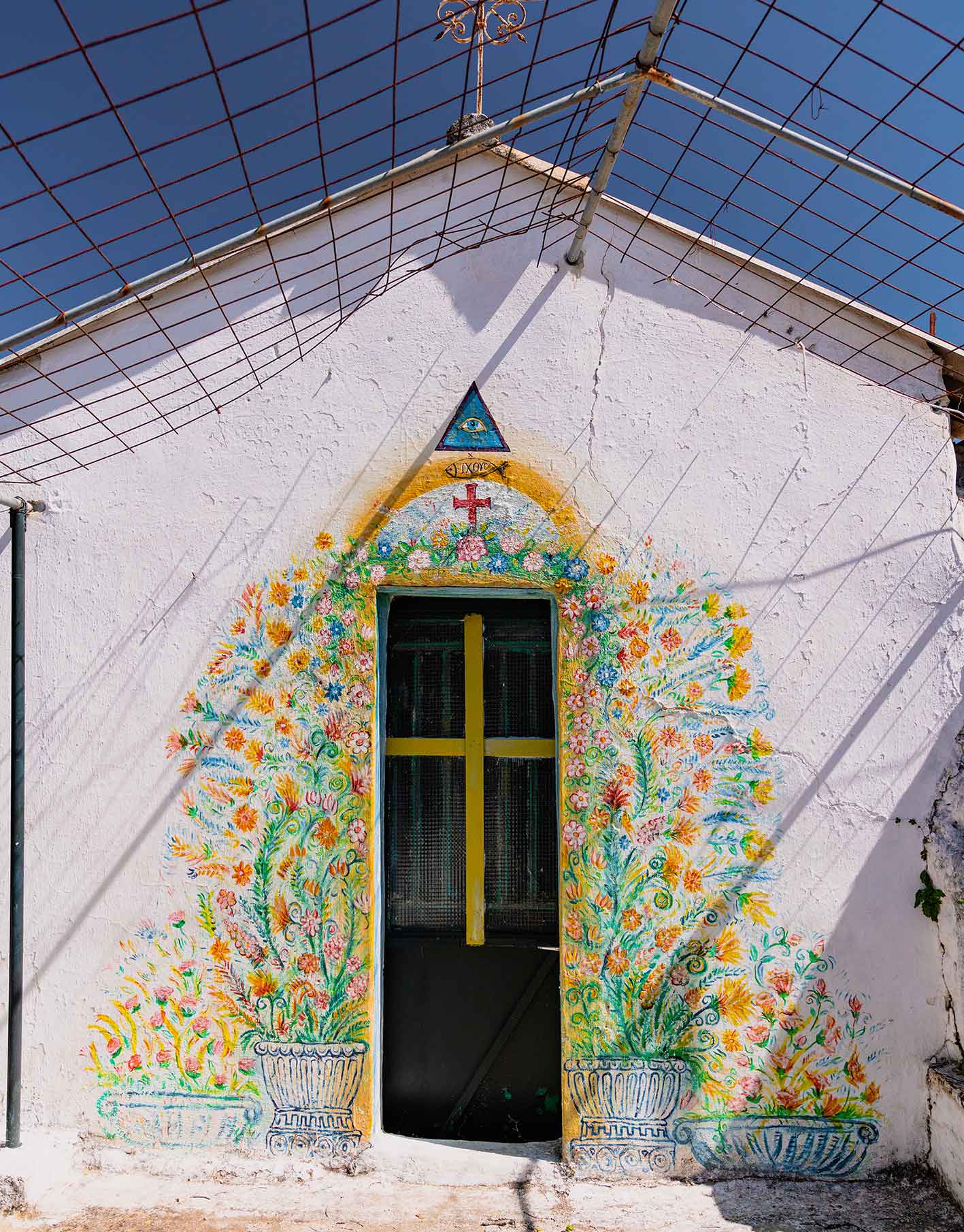
The small church of Pantokratoras at the inland of Corfu.
© Nicholas Mastoras
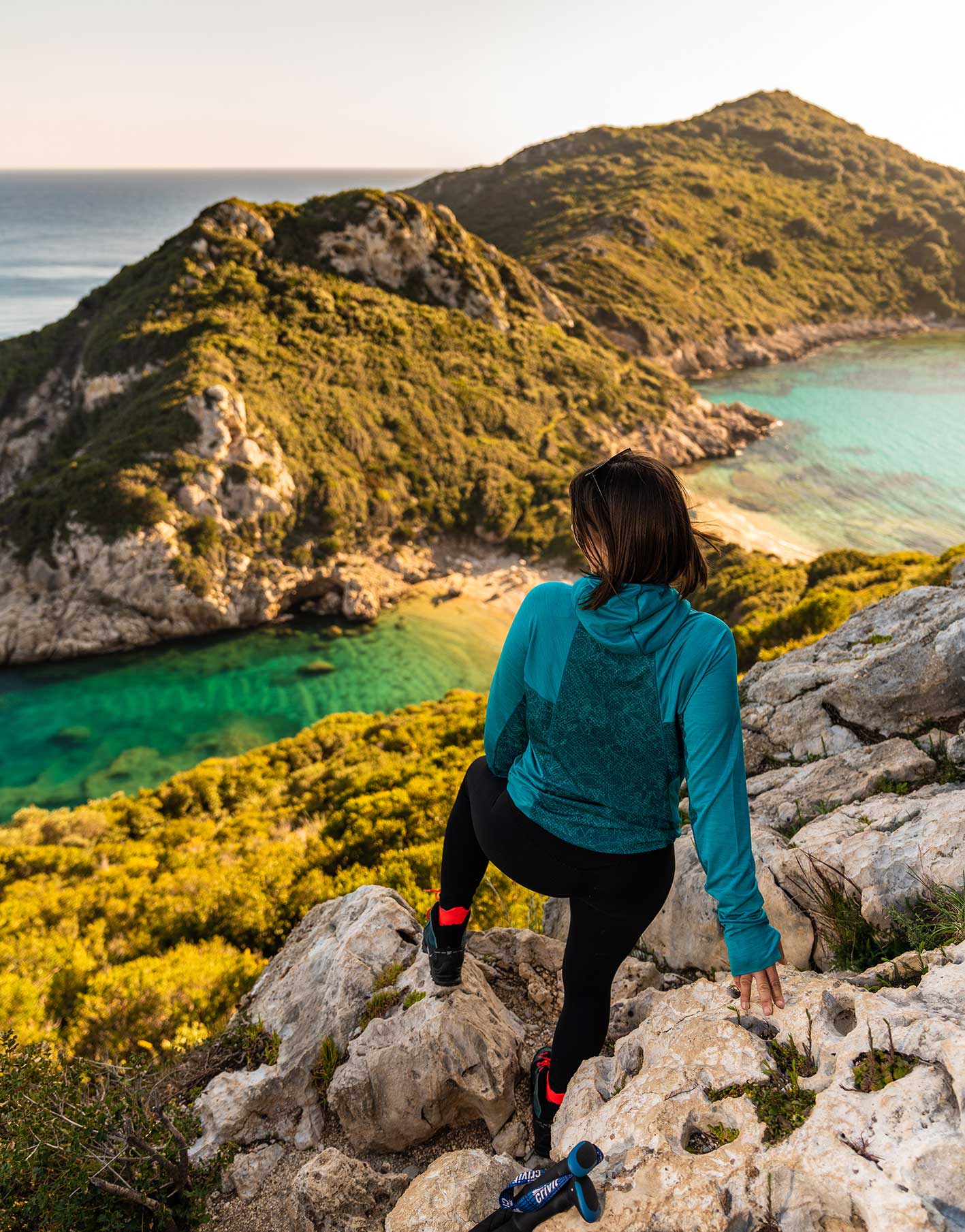
The twin beaches of Porto Timoni and Limni.
© Nicholas Mastoras
Hiking in Corfu is not something new. It definitely started before the trend of walking tourism was established. Perhaps the fact that the island has many visitors and permanent residents from abroad, who are more familiar with hiking than we are ̶ at least in the past ̶ played a role in this.
The most famous trail is Corfu Trail, about 200km long. This is the project of the British Hilary Whitton-Païpeti who, at the beginning of the new millennium and in collaboration with local walkers, looked for the old paths that used to connect the villages and connected them all into a long trail, starting from the southernmost part of Corfu (Asprokavos) and leading to the northernmost (Aghios Spyridonas), passing through the west coast.
Part of the walk we took in the middle part of Corfu along with the Mountaineering Association covered part of the Corfu Trail. Some trails do overlap, which seems only natural on a large island. However, there is a lack of coordination and all the parts involved (hikers, runners, race organizers, cyclists) use different signage, so the visitor that walks the paths comes across a multitude of different colored signs instead of distinctive signage. Apart from this, hiking fans and especially those who love several-day hiking, will enjoy walking in Corfu.
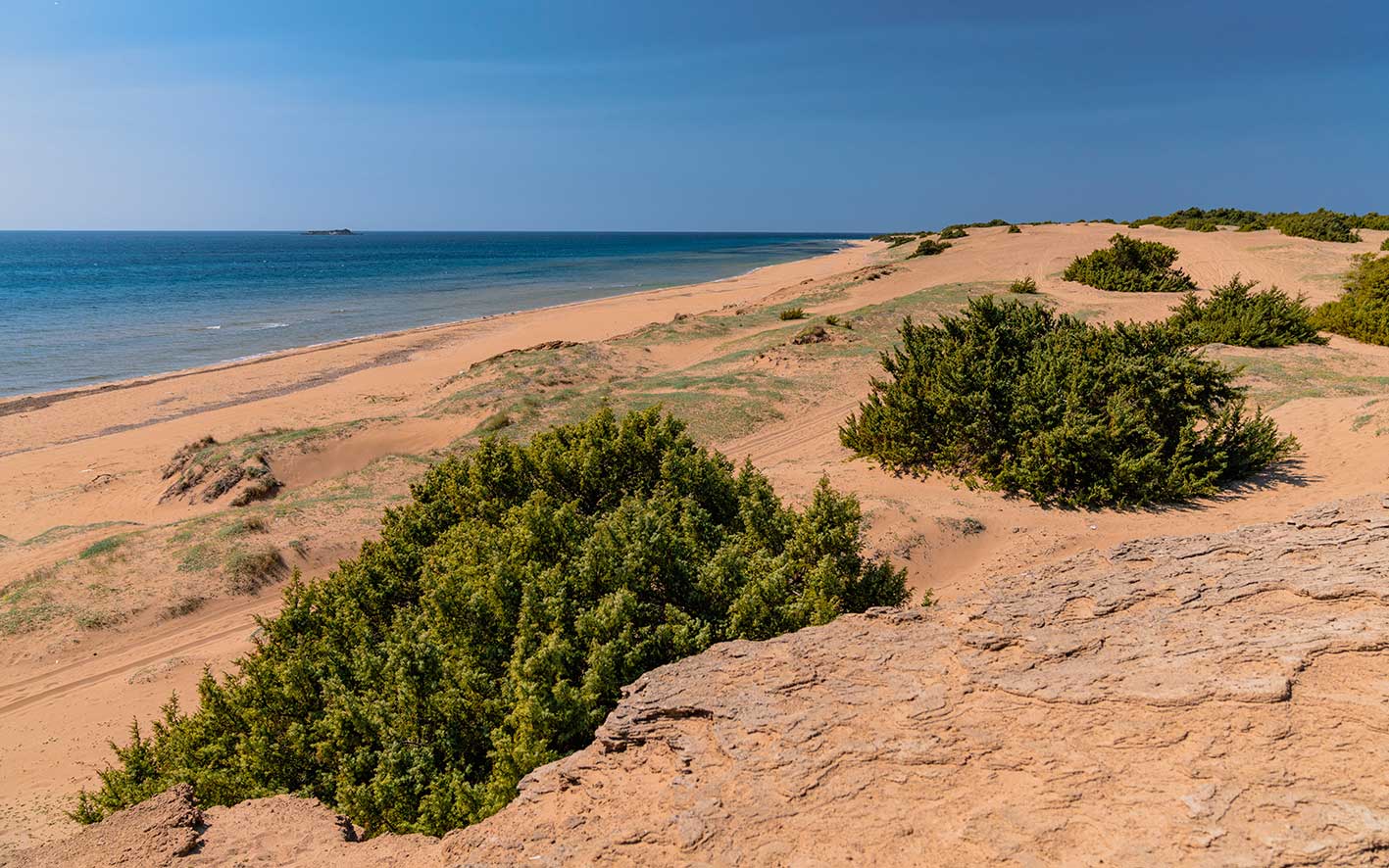
One of the most beautiful places in southern Corfu is the cedar forest located above Issos beach.
© Nicholas Mastoras
Not necessarily though. There is always the car. It is ideal to go on a road trip, on an island such as this one, because you can explore it all within two or three days. Discover the vast Corfiot olive groves with the tall Venetian olive trees (called lianolies) that cover large parts of the island. The problem is that the more you drive the more you realize that there are areas that have been left to chance; villages and settlements that remind of the dust and wilderness of the Wild West, waiting for the tourist season to start, with their architecture having nothing to do with the tradition and beauty of Corfu.
Palia Perithia, one of the most famous villages in the north of Corfu, does not belong to this category. It is an atmospheric village, built of stone, which has no permanent residents but stays alive thanks to the tavernas that open in selected periods (summer, long weekends etc.) to welcome local and foreign tourists. Here things are simple: Alkinoos’ taverna and Evdokia’s taverna, whom we found at the entrance of the village picking fennel to make cod pie, the volto (vaulted hut made of stones) in front of the old school, the sundial that can still be seen in the old town hall. Walk among the stone ruins and enjoy tsipouro (a pomace brandy), chatting and food.
If you are a nature lover, there are three more excursions that you can include in your road trip to be convinced of the variety of the Corfiot landscape. Staying in the north, do pass by the waterfalls of the Nymphs, just outside the homonymous village, to sit on the wooden benches and see the most spectacular water sight in Corfu inland, with the waters falling overwhelmingly.
To the west you will find the famous twin beaches of Porto Timoni and Limni, separated by a thin strip of land. You cannot get there by car; you have to take the stone path. It is worth stopping at a spot with a breathtaking view just before the beaches to gaze at them from above ̶ you will see other people huddled on the edge of the cliff to take pictures with the background of the two colors of the sea: on one side of one beach the sea is blue and on the other it is green.
For the finale, keep the magical beach of Issos, in southern Corfu. Dunes, cedars and rocks that have grown in volume due to the thick layer of sand that has settled on them. Sea, sky and horizon. An excursion for those who enjoy playing on the dunes and for those who love silence.
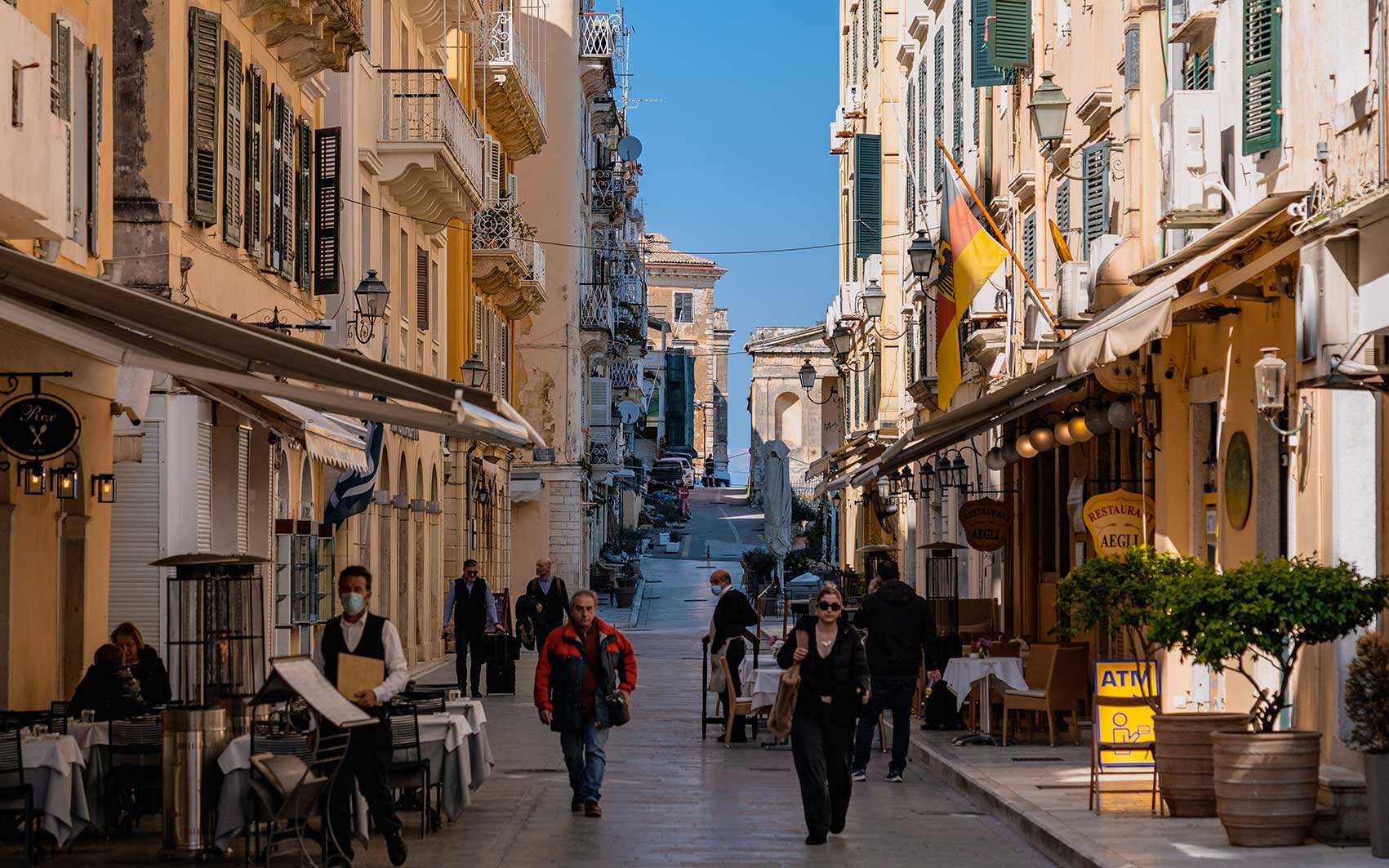
The city of Corfu, just before the start of the season, is preparing to welcome visitors.
© Nicholas Mastoras
And from the countryside, to the city of Corfu, which is a world in itself, completely different from the rest of the island. The best time to visit it is spring. It isn’t only less hot, there are also fewer tourists and so there is room for the people of Corfu to find their place in public and to show who they really are, without being overwhelmed by crowds of German, English, French, Italian and Polish tourists, who visit the island massively.
Judging by Spianada, the huge square that is divided into two parts, Panο and Kato (Upper and Lower), the people of Corfu love spending time outdoors. They have such a solid and colorful presence, that by scanning the square, from end to end, you can’t tell who the protagonist of the picture is, the monuments or people. The statue of the English commissioner Sir Frederick Adam in front of the Old Palace or the boy with the orange hair sitting on the grass smoking, like a real Sex Pistols fan? The epic-lyric Rotunda (Maitland Monument), showing the architectural splendor of the British Empire in its protectorates, or the girl on the skate running behind a dove chasing dog? A bunch of people listening to rap music or a bunch of people listening to rebetiko? Spianada is actually one of the most beautiful squares I have ever seen. Spread out, green, spacious, vivid, it combines the past with the present of Corfu.
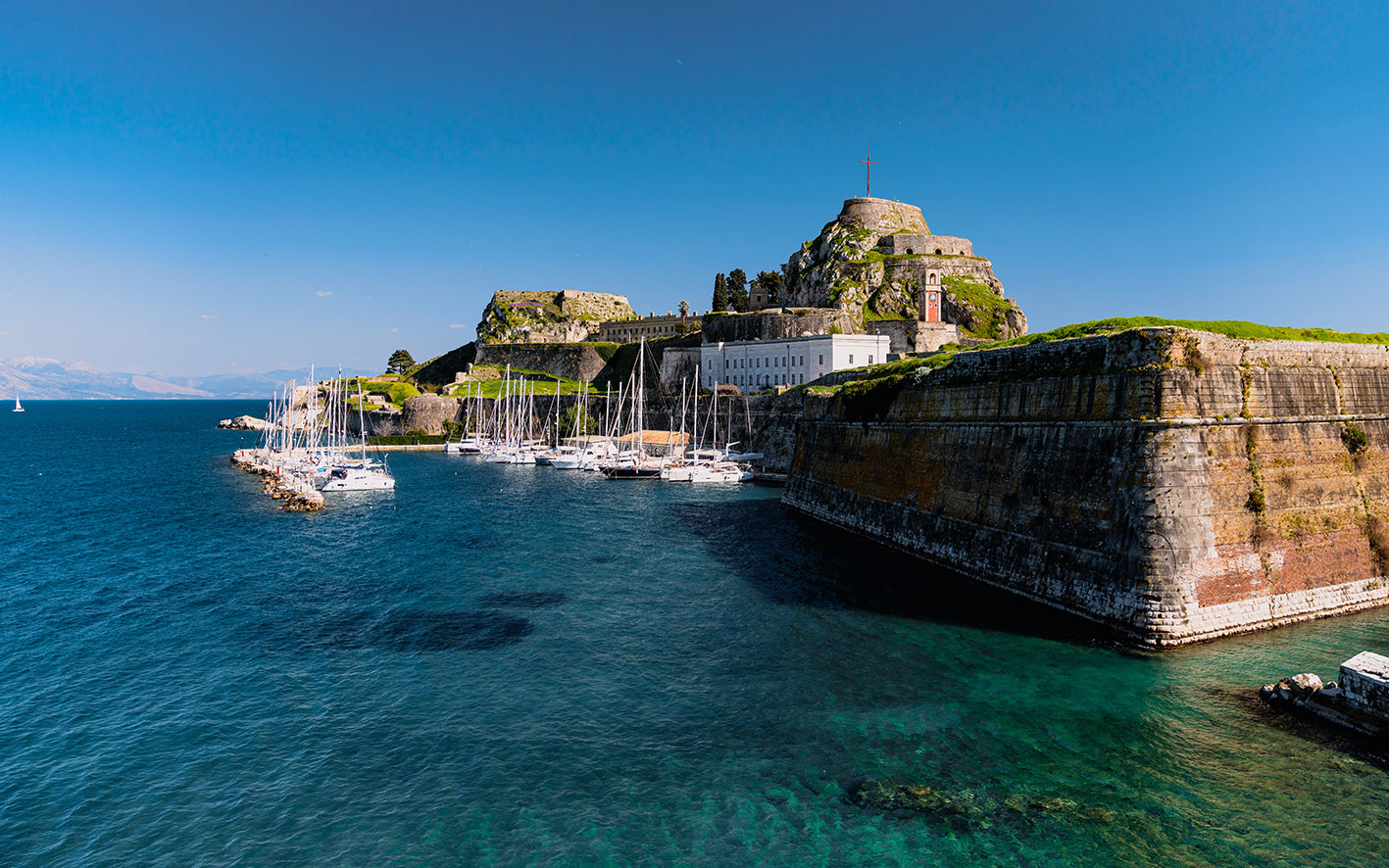
The old fortress of Corfu on the peninsula that borders the eastern edge of the city.
© Nicholas Mastoras
In general, the public space of Corfu is interesting. From the narrow alleys to the wide sidewalks and the pedestrian street of Liston, which is a direct reference to St. Mark’s Square in Venice, the city offers countless visual stimuli, which serve as occasions to explore its history. The church of Aghios Georgios in the Old Fortress is orthodox today but, in the past, used to be Anglican and that is why it is built in a neoclassical style, therefore the visitor sees an orthodox church in the shell of an ancient Greek temple. The roof of Aghios Spyridonas has nothing to do with the standard Byzantine iconography; it looks more like a renaissance painting.
Douglas’s Obelisk, dedicated to the English commissioner Howard Douglas, is reminiscent of the wings that were once spread over the island by the British Empire, which is presented as a half-naked woman, holding a Cornucopia (i.e. the Horn of Plenty).
More hands, alive this time, moving right and left, opening shutters, hanging the washing out to dry on ropes, presenting us the ritual of Corfu laundry. As for the Capo d’ Istria clothing store, it looks like its name is a tribute to the greatest leader that Corfu has produced. And it’s not even a museum, it’s a boutique. English rule, Venetian rule, free revolted Greece, bourgeoisie and populism, showing off and spontaneity come to life through the material culture of Corfu and the habits of the Corfiots. It’s part of their lives. Today Corfu is a free island, where Italians and English no longer come as owners, but as tourists. They visit Corfu regularly, admire and respect it.
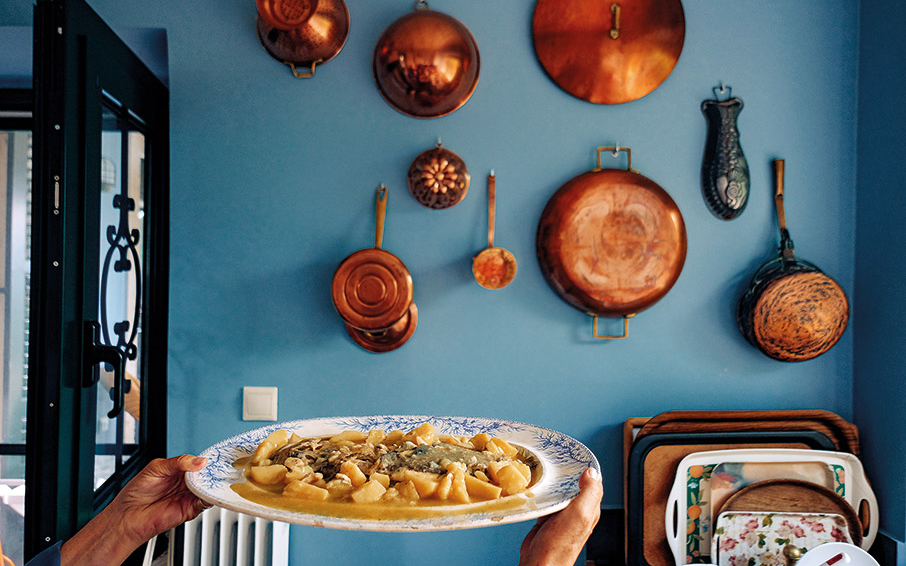
One of the well-known Corfiot dishes is bianco.
© Michalis Pappas
We got a taste of the hinterland and the city of Corfu. But how does all this translate gastronomically? On a large island, where does homogeneity stop and where do individual gastronomic identities begin?
Aristotelis Megoulas, chef and creator of the Pomo d’ Oro restaurant, is suitable to tell us about this. He describes the cuisine of Corfu as “the epitome of poor Mediterranean cuisine based on seasonality and the intelligence of the people who are expected to manage the available raw materials.” With diverse nature, mountainous and lowland areas, lakes, fishing villages and salt flats, the Corfu basket had everything (fish, meat, legumes and vegetables). At the same time, the influences from mainland Greece, the rest of the Ionian, the Europeans and the Russians deeply enriched the Corfiot cuisine. “There are influences even from Byzantium, from the families who came to Corfu when Constantinople fell.”
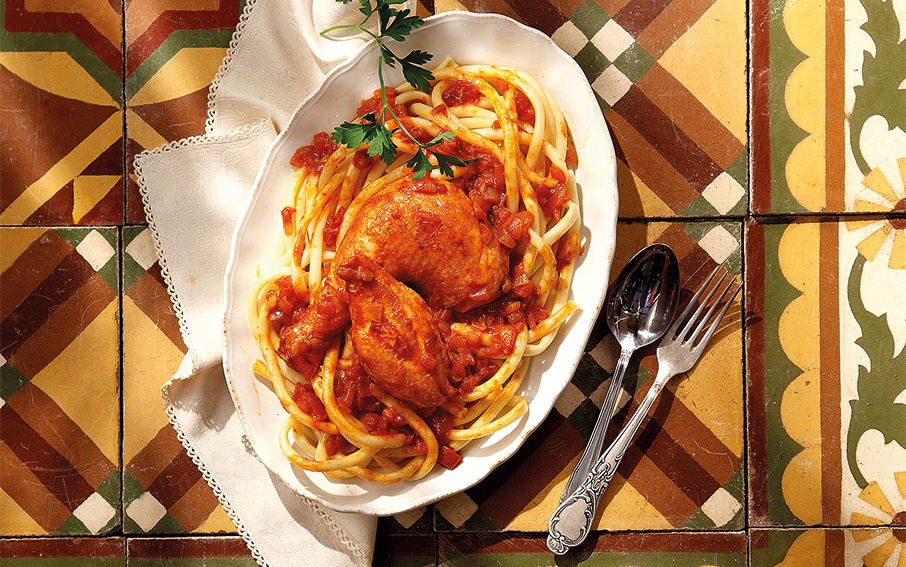
The famous pastitsada (or pastitsado).
© Giorgos Drakopoulos
In pre-tourism times, when differences in the island’s cuisine from place to place were even more distinct, we could divide the Corfiot gastronomy into three parts. “There was the cuisine of central Corfu, which covered the city and literally the middle part of the island, from east to west. In the city what was mainly developed was the bourgeois Corfiot cuisine enriched by all the cosmopolitan influences that existed on the island, since it was the administrative centre.” The south was completely different and clearly more introvert and despite having fisheries and salt pans, “it has always been a bit poorer.” Here, they used to eat a lot of fish, there were fava beans, legumes in general, grains and rice fields.” In the affluent rural north, with Mount Pantokratoras, the villages and the plains, the influence from Epirus was clear. “North Corfu’s cuisine included lots of pies (eg stuffed with rice). Pies with many peculiarities, some of which can be justified and some not.”
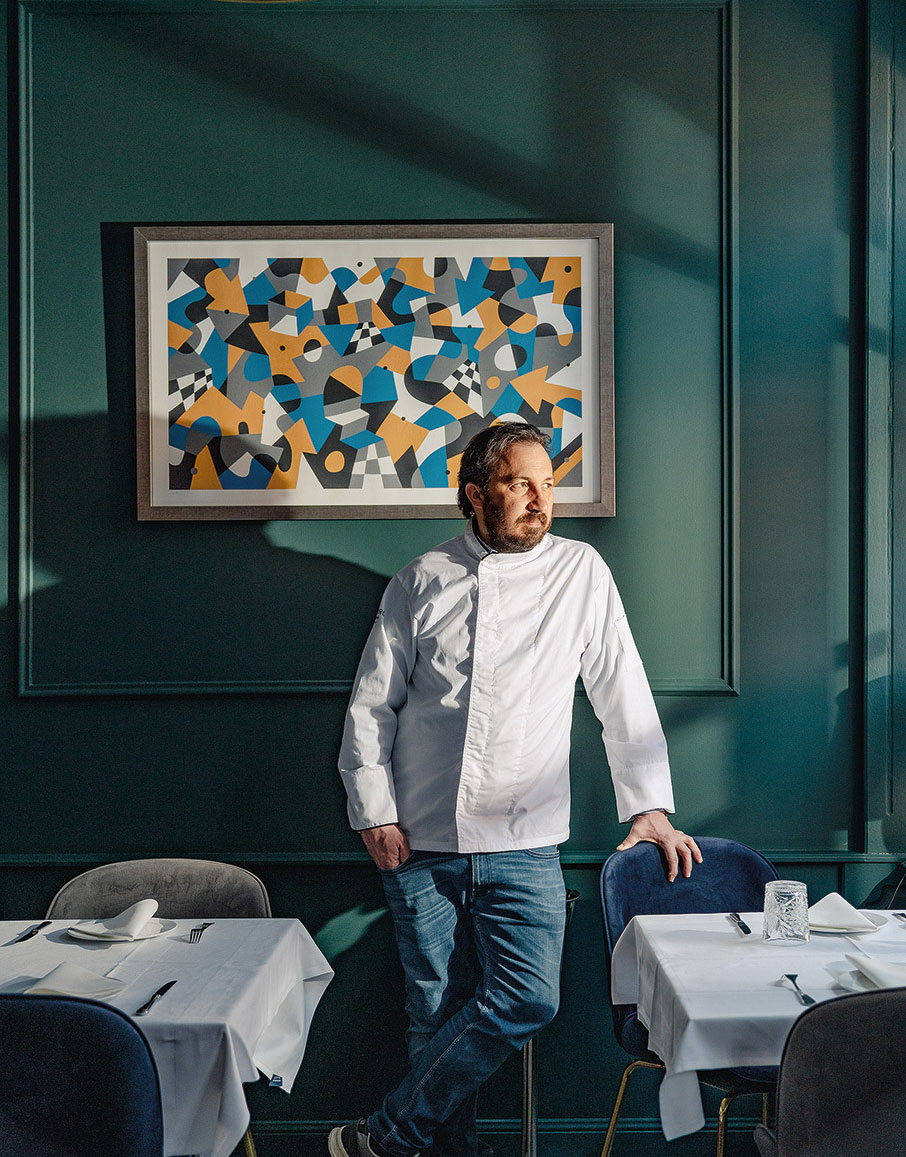
Aristotelis Megoulas at Pomo d’Oro restaurant.
© Nicholas Mastoras
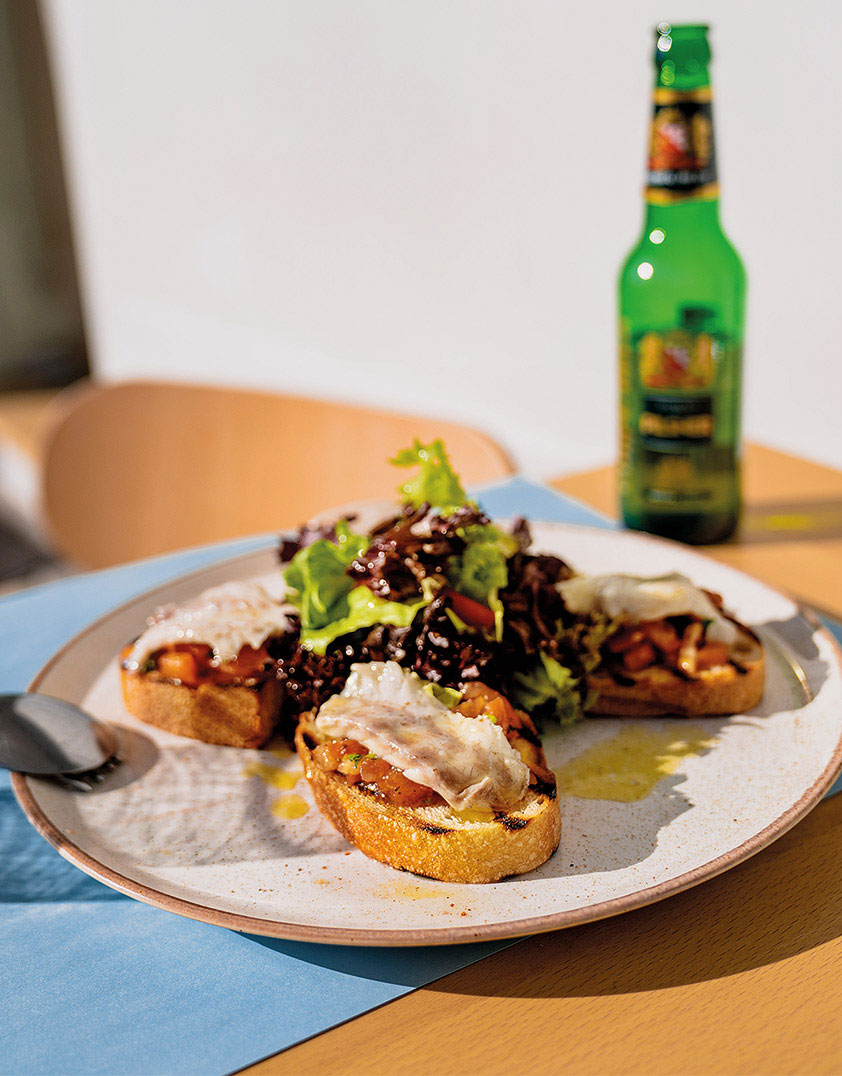
Fyssalida
© Nicholas Mastoras
Today, the taste peculiarities of each region are almost dissolved. “For example, we are talking about the classic Corfiot recipes: burdeto, pastitsado, sofrito, bianco. It is also wrong to call them recipes, because actually they are techniques, which were based on the materials available in each region and time of year. “People used these techniques regardless of the protein available, whether plant or animal.” In the case of the famous pastitsado or pastitsada, as we non-Corfiots call it (both are correct), history has shown that it can be prepared with rooster, beef, lamb, mutton, but also with octopus in fishing villages or simply with olives. And that’s how the myth that pastitsado requires beef is dispelled. “
Now that we are only a breath away from Easter, those of you who are going to travel to Corfu must keep in mind the richness of Easter dishes, such as tsilihourda, that is, the Corfiot mageiritsa (local soup with minced lamb pluck and casings), which “in some parts of the island is red, with cayenne pepper spice, in other parts it is prepared with egg and lemon sauce, in some cases rice is added and in some not”. Detect the strong symbolisms born by “the only truly Greek sauce, since all the rest were influences from abroad”, the egg and lemon sauce, which in Corfu is associated with celebrations. Look for restaurateurs, cooks or just Corfiot cooking devotees, friends of friends who resist uniformity and maintain in their cuisine a part of the huge gastronomic palette of Corfu.
You can get to Corfu by air (in a search we did for the end of April, we found Athens-Corfu tickets with return at 130 euros). Alternatively, you can drive to Igoumenitsa (430km/5 hours from Athens, with a cost of fuel-tolls of 85 euros, one way) and from there take the ferry to Corfu (1½hour/ticket 10 euros).
Acanthus Blue (13, 3rd lane of Mitropolitou Athanasiou, Tel. (+30) 26610.440.59, at 210 euros for a double room, breakfast included) is a boutique hotel housed in a restored mansion dating back to 1700. It has simple, luxurious rooms, overlooking the garden and the sea, in which the old stone relief of the walls stands out. Rodostamo Hotel & Spa (3 Kyknon, Tel. (+30) 26614.403.00, at 130 euros for a double room, breakfast included) is a luxurious resort, located in Kommenos bay, 10km from the city of Corfu, which has rooms, suites, bungalows and villas. The staff is polite and breakfast is top-notch. Please note that it is aimed at adults and children over 12 years old.
In the city of Corfu, sit down for the first coffee of the day at Bristol Café (Tel. (+30) 693.666.0101), for brunch at Josephine (Tel. (+30) 26610.272.75), for an afternoon liqueur at Liston Gastrotheque (Tel. (+30) 26610.455.28) and to eat at the Pomo d’Oro (Tel. (+30) 26610.286.80). Here you will try dishes based on seasonality, with a lot of thought lying behind their composition. The day we visited it, the menu included, among other things, Boukari salad (grilled beets, shrimp, butter flavored with mandarin and Kozani saffron threads) and Granny’s pasta (spaghetti alla chitarra, pastitsado rooster ragout). If you love eating fish, you should visit Fyssalida (Tel. (+30) 26610.821.50), where you can taste classic and tweaked fish and seafood recipes, such as Bourdeto with hot and sweet paprika and mashed potatoes. Do have a Corfu Beer with your food; it is a local pilsner. In Palia Perithia, in northern Corfu, you will find the taverna Palia Perithia (Tel. (+30) 26630.980.55) that opened back in 1863 by the current owner’s grandfather and used to operate both as a tsipouradiko (restaurant serving tsipouro, a pomace brandy, with meze) and as a delicatessen where you could also buy groceries. The decoration brings an air of this old era in the interior, with the old grandfather’s bed being turned into a seat. It is also worth visiting the adjacent taverna of Evdokia (Tel. (+30) 26630.986.35), who is in love with gastronomy, picks fennel and dries laurel so that her food has the flavor of Palia Perithia. In southern Corfu, near Issos beach there is Ammolofos taverna (Tel. (+30) 26627.707.20), with generous portions and tasteful decoration that distinguish it from all the standard touristic tavernas.
The people of Corfu do not speak, they sing. The melodic and light Corfiot idiom, with words sounding like neologisms in the ears of an uninitiated, will put a smile on your face. You could get an idea of the huge linguistic wealth of Corfu by visiting the blog “Corfu Dictionary of 5,000 Words” (kerkiraikolexiko.blogspot.com), a really interesting online project including words in standard Greek and their translation into Corfiot. Here we learned that Demosio (Public Sector), in Corfiot is called Camari, aftokinito (car) is called caro, chartonomisma (banknote) is called carta moneda and lepto (minute) is called minuto. Theatrizomai means to embarrass oneself, ipotecaro is to mortgage, ibizaromai is to interfere and capatsaro means to impose on somebody.
If you need information or guidance on the paths of Corfu (whether they are cleaned, adequately marked etc.), please contact the Hiking and Mountaineering Association, [email protected].
Explore the Corfu Trail with Aperghi Travel agency, Tel. (+30) 26610.487.13.
Keep in mind that your mobile phone in some parts of the island might automatically connect an Albanian network, in which case charges are different.
Discover Greece’s islands in September with...
Charming architecture, unique beaches, rich history,...
On the Greek island of Hydra,...
This spring, five majestic peaks across...